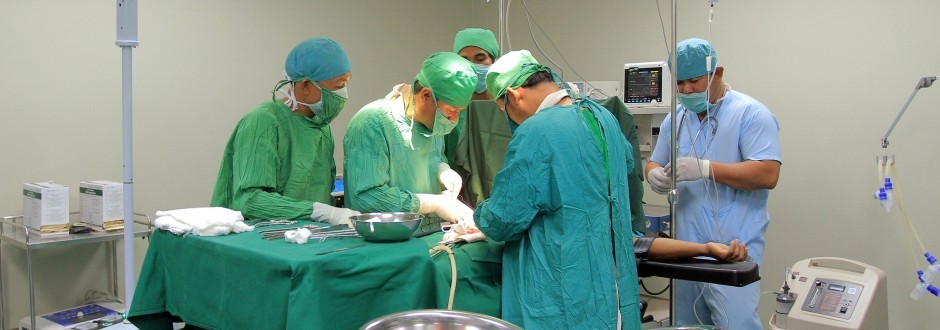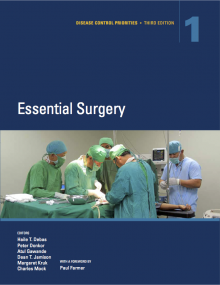
Copyright: Chhor Sokunthea/World Bank
Foreword by Dr. Paul Farmer

The past few decades have seen enormous changes in the global burden of disease. Although many people, especially those living in (or near) poverty and other privations, are familiar with heavy burdens and much disease, the term “global burden of disease” emerged in public health and in health economics only in recent decades. It was coined to describe what ails people, when, and where, and just as reliable quantification is difficult, so too is agreeing on units of analysis. Does this term truly describe the burden of disease of the globe? Of a nation? A city?
We have also learned a thing or two about how to assess this global burden, and how to reveal its sharp local variation and transformation with changing conditions ranging from urbanization to a global rise in obesity (Murray, Lopez, and Jamison 1994; Murray and Lopez 1997; Lopez and others 2006; Mathers, Fat, and Boerma 2008; Lozano and others 2013; Jamison and others 2013). Measuring illness has never been easy, nor has attributing a death—whether premature or at the end of fourscore years—to a specific cause (Yarushalmy and Palmer 1959; Rothman 1976; Byass 2010; Byass and others 2013). Even countries with sound vital registries generate data of varying quality, given that cause of death is rarely confirmed by autopsy (Mathers and others 2005; Mahapatra and others 2007). When nonlethal or slowly debilitating illness is added to considerations of burden of disease, the challenge of both measurement and etiologic claims can appear overwhelming (Kleinman 1995; Arnesen and Nord 1999; Salomon and others 2012; Voigt and King 2014).
The challenges of measuring the burden of disease only get more complex when attempting to use the category of surgical disease. For starters, even experts do not agree on definitions of ostensibly simple terms such as “surgical disease” (Debas and others 2006; Duba and Hill 2007; Ozgediz and others 2009; Bickler and others 2010). Some illnesses rarely considered to be surgical problems pose threats to health if neglected long enough. Some trends are clear, however. Take the examples offered by Haiti and Rwanda, where different types of trauma (intentional or the result of crush injuries) account for a majority of young-adult deaths. How many of these deaths are classified as surgical disease? If someone dies of acute abdomen—and if his or her death is recorded at all—was it attributed to appendicitis or to enteric fever? Are these infectious complications of surgical disease or surgical complications of infectious disease? If a child with untreated epilepsy falls into a fire and succumbs from burns, how is this death reported, if it is registered at all? Clinicians who work in settings far from any pathology laboratory have seen infected tumors (misdiagnosed as primary infection) as often as they have discovered that a suspected breast cancer was a long-untreated canalicular abscess. Brain tumors are revealed to be tuberculomas and vice versa.
A sound grasp of the burden of disease is essential to those seeking data-driven methods to design and evaluate policies aimed at decreasing premature death and suffering (Nordberg, Holmberg, and Kiugu 1995; Taira, McQueen, and Burkle 2009; Poenaru, Ozgediz, and Gosselin 2014). But surgical disease was not often on the agenda. The immensity and complexity of the task of quantifying the surgical burden of disease has led many to avoid that task, leading to an analytic vacuum with adverse consequences. For too long, the global health movement has failed to count surgery as an integral part of public health. Prevailing wisdom dictated that the surgical disease burden was too low, surgical expenses too high, and delivery of care too complicated. The predecessor to this volume, the second edition of Disease Control Priorities in Developing Countries (DCP2; Jamison and others 2006), changed this paradigm. Published in 2006, it included, for the first time in a major global health platform, sustained attention to surgery. The editors sought to marshal the experience of its contributors to help quantify and classify the burden of surgical disease. Admittedly, this most widely cited estimate of surgical need—11 percent of the global burden of disease was surgical—was based on the best educated guesses of a convenience sample of 18 surgeons on an online survey. Nonetheless, this figure was later validated by the common experience of providers and patients alike from the poorest reaches of the world: the burden of surgical disease was never trivial.
DCP3 builds upon this foundation and substantially improves it. It enhances our understanding of DCP2’s pioneering work with more robust methodology. Over the years, researchers—led by the editors of and many of the contributors to this volume—have devoted attention to cancers, orthopedic injuries, disfigurements after burns, congenital defects like cleft lip and palate, blindness from cataracts, and the many causes of death from acute surgical needs. This volume collates the knowledge gained through the increased attention to global surgery since 2006.
This new volume of DCP underlines the central importance of surgical care, since by these measures surgical disease is thought to account for a significant portion of the global disease burden. The Essential Surgery volume of DCP3 helps definitively dispel many of the myths about surgery’s role in global health, in part by showing the very large health burden from conditions that are primarily or extensively treatable by surgery. It dispels the myth that surgery is too expensive by showing that many essential surgical services rank among the most cost-effective of all heath interventions. It begins to dispel the myth that surgery is not feasible in settings of poverty by documenting many successful programs that have improved capacity, increased access, and enhanced quality of surgical care in countries across the globe.
As argued many times in the past—and worth repeating to clinical colleagues, students, trainees, and diverse interlocutors—global surgery is one of the most exciting frontiers in the quest for global health equity. Patients and providers, along with those who set and evaluate policies, will want (or need) to join this quest if we are to avert unnecessary suffering. We all have cause to be grateful for the many individuals whose time and energy have been invested in producing the wealth of knowledge presented in the Essential Surgery volume of DCP3.
Paul Farmer
Harvard Medical School
Brigham and Women's Hospital
Partners in Health
References:
Arnesen, T., and E. Nord. 1999. “The Value of DALY Life: Problems with Ethics and Validity of Disability Adjusted Life Years.” BMJ 319 (7222): 423–25.
Bickler, S., D. Ozgediz, R. Gosselin, T. Weiser, D. Speigel, and others. 2010. “Key Concepts for Estimating the Burden of Surgical Conditions and the Unmet Need for Surgical Care.” World Journal of Surgery 34 (3): 374–80.
Byass, P. 2010. “The Imperfect World of Global Health Estimates.” PLOS Medicine 7: e1001006.
———, M. de Courten, W. J. Graham, L. Laflamme, A. McCaw-Binns, and others. 2013. “Reflections on the Global Burden of Disease 2010 Estimates.” PLOS Medicine 10: e1001477.
Debas, H. T., R. Gosselin, C. McCord, and A. Thind. 2006. “Surgery.” In Disease Control Priorities in Developing Countries, 2nd edition, edited by D. T. Jamison, J. G. Breman, A. R. Measham, G. Alleyene, M. Claeson, D. B. Evans, P. Jha, A. Mills, and P. Musgrove, 1245–59. Washington, DC: World Bank and Oxford University Press.
Duba, R. B., and A. G. Hill. 2007. “Surgery in Developing Countries: Should Surgery Have a Role in Population-Based Health Care?” Bulletin of the American College of Surgeons 92 (5): 12–18.
Jamison, D. T., J. G. Breman, A. R. Measham, G. Alleyne, M. Claeson, D. B. Evans, P. Jha, A. Mills, and P. Musgrove, eds. 2006. Disease Control Priorities in Developing Countries, 2nd edition. Washington, DC: World Bank and Oxford University Press.
Jamison, D. T., L. H. Summers, G. Alleyne, K. J. Arrow, S. Berkley, and others. 2013. “Global Health 2035: A World Converging within a Generation.” The Lancet 382 (9908): 1898–955.
Kleinman, A. 1995. “A Critique of Objectivity in International Health.” In Writing at the Margin: Discourse between Anthropology and Medicine, edited by A. Kleinman. Berkeley, CA: University of California Press.
Lopez, A. D., C. D. Mathers, M. Ezzati, D. T. Jamison, and C. J. L. Murray. 2006. “Global and Regional Burden of Disease and Risk Factors, 2001: Systematic Analysis of Population Health Data.” The Lancet 367 (9524): 1747–57.
Lozano, R., M. Naghavi, K. Foreman, S. Lim, K. Shibuya, and others. 2013. “Global and Regional Mortality from 235 Causes of Death for 20 Age Groups in 1990 and 2010: A Systematic Analysis for the Global Burden of Disease Study 2010.” The Lancet 380 (9859): 2095–128.
Mahapatra, P., K. Shibuya, A. D. Lopez, F. Coullare, F. C. Notzon, and others. 2007. “Civil Registration Systems and Vital Statistics: Successes and Missed Opportunities.” The Lancet 370 (9599): 1653–63.
Mathers, C., D. M. Fat, and J. T. Boerma. 2008. The Global Burden of Disease: 2004 Update. Geneva, Switzerland: World Health Organization.
Mathers, C. D., M. A. Fat, M. Inoue, C. Rao, and A. D. Lopez. 2005. “Counting the Dead and What They Died From: An Assessment of the Global Status of Cause of Death Data.” Bulletin of the World Health Organization 83 (3): 161–240.
Murray, C. J. L., and A. D. Lopez. 1997. “Global Mortality, Disability, and the Contribution of Risk Factors: Global Burden of Disease Study.” The Lancet 349 (9063): 1436–42.
———, and D. T. Jamison. 1994. “The Global Burden of Disease in 1990: Summary Results, Sensitivity Analysis and Future Directions.” Bulletin of the World Health Organization 72 (3): 495–509.
Nordberg, E., S. Holmberg, and S. Kiugu. 1995. “Output of Major Surgery in Developing Countries: Towards a Quantitative Evaluation and Planning Tool.” Tropical and Geographical Medicine 47 (5): 206–11.
Ozgediz, D., R. Hsia, T. Weiser, R. Gosselin, D. Spiegel, and others. 2009. “Population Health Metrics for Surgery: Effective Coverage of Surgical Services in Low-Income and Middle-Income Countries.” World Journal of Surgery 33 (1): 1–5.
Poenaru, D., D. Ozgediz, and R. A. Gosselin. 2014. “Burden, Need, or Backlog: A Call for Improved Metrics for the Global Burden of Surgical Disease.” International Journal of Surgery 12 (5): 483–86.
Rothman, K. J. 1976. “Causes.” American Journal of Epidemiology 104 (6): 587–92.
Salomon, J. A., T. Vos, D. R. Hogan, M. Gagnon, M. Naghavi, and others. 2012. “Common Values in Assessing Health Outcomes from Disease and Injury: Disability Weights Measurement Study for the Global Burden of Disease Study 2010.” The Lancet 380 (9859): 2129–43.
Taira, B. R., K. McQueen, and F. M. Burkle. 2009. “Burden of Surgical Disease: Does the Literature Reflect the Scope of the International Crisis?” World Journal of Surgery 33 (5): 893–98.
Voigt, K., and N. B. King. 2014. “Disability Weights in the Global Burden of Disease 2010 Study: Two Steps Forward, One Step Back?” Bulletin of the World Health Organization 92 (3): 226–28.
Yerushalmy, J., and C. E. Palmer. 1959. “On the Methodology of Investigations of Etiologic Factors in Chronic Diseases.” Journal of Chronic Disease 10 (1): 27–40.

